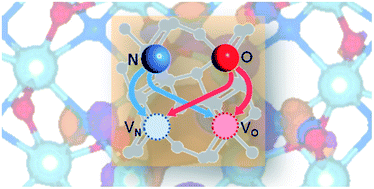Vacancy diffusion barriers in TaON and Ta3N5 water-splitting photocatalysts†
Abstract
Mixed anion semiconductors such as oxynitrides offer a wide range of properties that can be tuned for various catalytic applications, such as photocatalytic water splitting. In this work, first-principles simulations are used to predict the competing stabilities and mobilities of nitrogen and oxygen anion vacancies in the archetypal (oxy)nitride photocatalysts TaON and Ta3N5. The results demonstrate how the local Ta5+ coordination environment, vacancy defect charge and anion coordination number each influence the dominant ionic diffusion mechanism. Defect charge is intrinsically tied to the nature and kinetics of defect migration in these materials. Specifically, for neutral and low-charge defects in TaON, oxygen anion diffusion dominates ionic mobility, while higher charge states impede oxygen diffusion and simultaneously lower nitrogen diffusion barriers. This result provides a potential explanation for why TaON and Ta3N5 (and related (oxy)nitrides) are prone to becoming nitrogen deficient under catalytic operating conditions. Charge additionally stabilises oxygen anti-site defects in TaON, and oxygen impurity defects in Ta3N5, which is consistent with the tendancy of these materials to undergo oxidative decomposition, reforming pure oxide compounds such as Ta2O5. These insights highlight the importance of metal ion coordination and structural packing in retaining nitrogen content in oxynitride semiconductors for enhanced stability.



 Please wait while we load your content...
Please wait while we load your content...